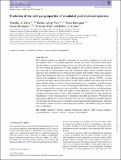Evolution of the cold gas properties of simulated post-starburst galaxies
Abstract
Post-starburst galaxies are typically considered to be a transition population, en route to the red sequence after a recent quenching event. Despite this, recent observations have shown that these objects typically have large reservoirs of cold molecular gas. In this paper we study the star-forming gas properties of a large sample of post-starburst galaxies selected from the cosmological, hydrodynamical EAGLE simulations. These objects resemble observed high-mass post-starburst galaxies both spectroscopically and in terms of their space density, stellar mass distribution, and sizes. We find that the vast majority of simulated post-starburst galaxies have significant gas reservoirs, with star-forming gas masses ≈109 M⊙, in good agreement with those seen in observational samples. The simulation reproduces the observed time evolution of the gas fraction of the post-starburst galaxy population, with the average galaxy losing ≈90 per cent of its star-forming interstellar medium in only ≈600 Myr. A variety of gas consumption/loss processes are responsible for this rapid evolution, including mergers and environmental effects, while active galactic nuclei play only a secondary role. The fast evolution in the gas fraction of post-starburst galaxies is accompanied by a clear decrease in the efficiency of star formation due to a decrease in the dense gas fraction. We predict that forthcoming ALMA observations of the gas reservoirs of low-redshift post-starburst galaxies will show that the molecular gas is typically compact and has disturbed kinematics, reflecting the disruptive nature of many of the evolutionary pathways that build up the post-starburst galaxy population.
Citation
Davis , T A , van de Voort , F , Rowlands , K , McAlpine , S , Wild , V & Crain , R A 2019 , ' Evolution of the cold gas properties of simulated post-starburst galaxies ' , Monthly Notices of the Royal Astronomical Society , vol. 484 , no. 2 , pp. 2447-2461 . https://doi.org/10.1093/mnras/stz180
Publication
Monthly Notices of the Royal Astronomical Society
Status
Peer reviewed
ISSN
0035-8711Type
Journal article
Collections
Items in the St Andrews Research Repository are protected by copyright, with all rights reserved, unless otherwise indicated.
Related items
Showing items related by title, author, creator and subject.
-
SDSS-IV MaNGA: How the stellar populations of passive central galaxies depend on stellar and halo mass
Oyarzún, Grecco A.; Bundy, Kevin; Westfall, Kyle B.; Tinker, Jeremy L.; Belfiore, Francesco; Argudo-Fernández, Maria; Zheng, Zheng; Conroy, Charlie; Masters, Karen L.; Wake, David; Law, David R.; McDermid, Richard M.; Aragón-Salamanca, Alfonso; Parikh, Taniya; Yan, Renbin; Bershady, Matthew; Sánchez, Sebastián F.; Andrews, Brett H.; Fernández-Trincado, José G.; Lane, Richard R.; Bizyaev, D.; Boardman, Nicholas Fraser; Lacerna, Ivan; Brownstein, J. R.; Drory, Niv; Zhang, Kai (2022-07-06) - Journal articleWe analyze spatially resolved and co-added SDSS-IV MaNGA spectra with signal-to-noise ratio ∼100 from 2200 passive central galaxies (z ∼ 0.05) to understand how central galaxy assembly depends on stellar mass (M*) and halo ... -
Secular-and merger-built bulges in barred galaxies
Mendez Abreu, Jairo; Debattista, V. P.; Corsini, E. M.; Aguerri, J. A. L. (2014-12) - Journal articleContext. Historically, galaxy bulges were thought to be single-component objects at the center of galaxies. However, this picture is now questioned since different bulge types with different formation paths, namely classical ... -
Galaxy And Mass Assembly (GAMA) : galaxy close pairs, mergers and the future fate of stellar mass
Robotham, A. S. G.; Driver, S. P.; Davies, L. J. M.; Hopkins, A. M.; Baldry, I. K.; Agius, N. K.; Bauer, A. E.; Bland-Hawthorn, J.; Brough, S.; Brown, M. J. I.; Cluver, M.; De Propris, R.; Drinkwater, M. J.; Holwerda, B. W.; Kelvin, L. S.; Lara-Lopez, M. A.; Liske, J.; Lopez-Sanchez, A. R.; Loveday, J.; Mahajan, S.; McNaught-Roberts, T.; Moffett, A.; Norberg, P.; Obreschkow, D.; Owers, M. S.; Penny, S. J.; Pimbblet, K.; Prescott, M.; Taylor, E. N.; van Kampen, E.; Wilkins, S. M. (2014-11-11) - Journal articleWe use a highly complete subset of the Galaxy And Mass Assembly II (GAMA-II) redshift sample to fully describe the stellar mass dependence of close pairs and mergers between 10(8) and 10(12)M(circle dot). Using the analytic ...

